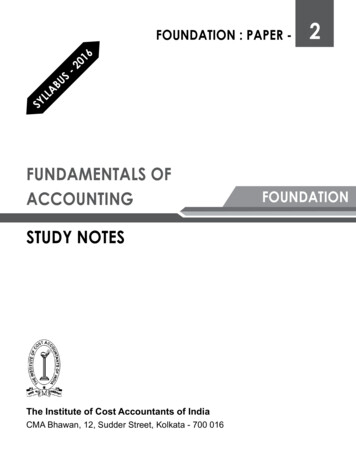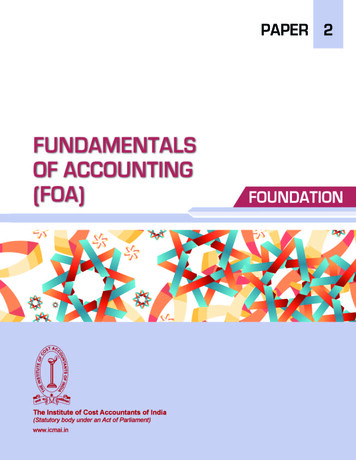
Transcription
2SYLLABUS-2016FOUNDATION : PAPER -FUNDAMENTALS OFACCOUNTINGSTUDY NOTESThe Institute of Cost Accountants of IndiaCMA Bhawan, 12, Sudder Street, Kolkata - 700 016FOUNDATION
First Edition : August 2016Reprint : April 2017Reprint : January 2018Published by :Directorate of StudiesThe Institute of Cost Accountants of India (ICAI)CMA Bhawan, 12, Sudder Street, Kolkata - 700 016www.icmai.inPrinted at :Mega Calibre Enterprises Pvt. Ltd.06/315 Action Area 3,New Town, Rajarhat,Kolkata 700 160.Copyright of these Study Notes is reserved by the Institute of CostAccountants of India and prior permission from the Institute is necessaryfor reproduction of the whole or any part thereof.
Syllabus - 2016PAPER 2: FUNDAMENTALS OF ACCOUNTING (FOA)Syllabus StructureABFundamentals of Financial AccountingFundamentals of Cost Accounting80%20%B20%A80%ASSESSMENT STRATEGYThere will be written examination paper of three hoursOBJECTIVESTo gain comprehensive understanding of all aspects relating to financial statements, principles,procedures of accounting and their application to different practical situationsLearning AimsThe syllabus aims to test the student’s ability to: Understand and explain the conceptual framework of Accounting Prepare Accounting for various entities under different situations Acquire basic concepts of Coat & Management Accounting relevant for managerial decisionmakingSkill set requiredLevel A: Requiring the skill levels of knowledge, comprehension,Section A : Fundamentals of Financial Accounting1. Accounting Fundamentals35%2. Accounting for Special Transactions20%3. Preparation of Final Accounts25%Section B: Fundamentals of Cost Accounting4. Fundamentals of Cost Accounting20%
SECTION A : Fundamentals of Financial Accounting [80 MARKS]1.Accounting Basics2.Accounting for Special Transactions3.Preparation of Final AccountsSECTION B: Fundamentals of Cost & Management Accounting [20 MARKS]4.Fundamentals of Cost AccountingSection A : Fundamentals of Financial Accounting [80 marks]1.2.3.Accounting Process(a)Accounting Principles, Concepts and Conventions(b)Capital and Revenue transactions - capital and revenue expenditures, capital and revenue receipts(c)Double entry system, Books of prime entry, Subsidiary Books, Cash Book(d)Journal, Ledger, Trial Balance(e)Depreciation - Methods (Straight Line and Diminishing Balance methods only)(f)Recti cation of Errors(g)Opening entries, Transfer entries, Adjustment entries, Closing entries(h)Bank Reconciliation StatementsAccounting for Special Transactions(a)Bills of Exchange (excluding accommodation bill, insolvency)(b)Consignment (cost price, invoice price, commission & valuation of stock)(c)Joint VenturePreparation of Final Accounts(a)Of a Pro t making concern (for sole proprietorship concern only)(i)Accounting treatment of bad debts, reserve for bad and doubtful debts, provision for discount ondebtors and provision for discount on creditors.(ii)Preparation of Trading Account, Pro t & Loss Account and Balance Sheet.(b)Of a Not-for- Pro t making concern(i)Preparation of Receipts and Payments Account(ii)Preparation of Income and Expenditure AccountSECTION B: Fundamentals of Cost Accounting [20 MARKS]4.Fundamentals of Cost Accounting(a) Meaning, De nition, Signi cance of Cost Accounting, its relationship with Financial Accounting &Management Accounting.(b) Classi cation of Costs(c) Format of Cost Sheet
ContentsSECTION - A: FUNDAMENTALS OF FINANCIAL ACCOUNTINGStudy Note 1 : Accounting Basics1.1Accounting Principles, Concepts and Conventions1.2Capital and Revenue transactions - capital and revenue expenditures, capital and15revenue receipts1.31Double entry system, Books of prime entry, Subsidiary Books, Cash Book, Journal,Ledger, Trial Balance241.4Depreciation - Methods (Straight Line and Diminishing Balance methods)741.5Recti cation of Errors871.6Opening entries, Transfer entries, Adjustment entries, Closing entries1041.7Bank Reconciliation Statements117Study Note 2 :Accounting for Specoal Transactions2.1Bills of Exchange (excluding accommodation bill, insolvency)1292.2Consignment (cost price, invoice price, commission & valuation of stock)1422.3Joint Venture158Study Note 3 : Preparation of Final Accounts3.1Pro t making concern (for sole proprietorship concern only)1763.2Not-for- Pro t making concern198SECTION - B: FUNDAMENTALS OF COST ACCOUNTINGStudy Note 4 : Fundamrntals of Cost Accounting4.1Meaning, De nition, Signi cance of Cost Accounting, its relationship with FinancialAccounting & Management Accounting2154.2Classi cation of Costs2274.3Format of Cost Sheet240
STUDY NOTE : 1ACCOUNTING BASICSTHIS STUDY NOTE INCLUDES:1.1 Accounting Principles, Concepts and Conventions1.2 Capital and Revenue transactions - capital and revenue expenditures,capital and revenue receipts1.3 Double entry system, Books of prime entry, Subsidiary Books, Cash Book, Journal, Ledger, Trial Balance1.4 Depreciation - Methods (Straight Line and Diminishing Balance methods)1.5 Rectification of Errors1.6 Opening entries, Transfer entries, Adjustment entries, Closing entries1.7 Bank Reconciliation Statements1.1 ACCOUNTING PRINCIPLES, CONCEPTS AND CONVENTIONSIntroduction to Financial AccountingBusiness is an economic activity undertaken with the motive of earning profits and to maximize the wealth for theowners. Business cannot run in isolation. Largely, the business activity is carried out by people coming together witha purpose to serve a common cause. This team is often referred to as an organization, which could be in differentforms such as sole proprietorship, partnership, body corporate etc. The rules of business are based on generalprinciples of trade, social values, and statutory framework encompassing national or international boundaries.While these variables could be different for different businesses, different countries etc., the basic purpose is to addvalue to a product or service to satisfy customer demand.The business activities require resources (which are limited & have multiple uses) primarily in terms of material, labour,machineries, factories and other services. The success of business depends on how efficiently and effectively theseresources are managed. Therefore, there is a need to ensure the businessman tracks the use of these resources.The resources are not free and thus one must be careful to keep an eye on cost of acquiring them as well. As thebasic purpose of business is to make profit, one must keep an ongoing track of the activities undertaken in courseof business. Two basic questions would have to be answered:(a) What is the result of business operations? This will be answered by finding out whether it has made profit or loss.(b) What is the position of the resources acquired and used for business purpose? How are these resources financed?Where the funds come from?The answers to these questions are to be found continuously and the best way to find them is to record all thebusiness activities. Recording of business activities has to be done in a scientific manner so that they reveal correctoutcome. The science of book-keeping and accounting provides an effective solution. It is a branch of socialscience. This study material aims at giving a platform to the students to understand basic principles and concepts,which can be applied to accurately measure performance of business. After studying the various chapters includedherein, the student should be able to apply the principles, rules, conventions and practices to different businesssituations like trading, manufacturing or service.DEFINITIONSDefinition of AccountingDefinition by the American Institute of Certified Public Accountants (Year 1961):“Accounting is the art of recording, classifying and summarizing in a significant manner and in terms of money,transactions and events which are, in part at least, of a financial character, and interpreting the result thereof”FUNDAMENTALS OF ACCOUNTING1
Definition by the American Accounting Association (Year 1966):“The process of identifying, measuring and communicating economic information to permit informed judgmentsand decisions by the users of accounting”.Objectives of Accounting(i) Providing Information to the Users for Rational Decision-makingThe primary objective of accounting is to provide useful information for decision-making to stakeholders suchas owners, management, creditors, investors, etc. Various outcomes of business activities such as costs, prices,sales volume, value under ownership, return of investment, etc. are measured in the accounting process. Allthese accounting measurements are used by stakeholders (owners, investors, creditors/bankers, etc.) in courseof business operation. Hence, accounting is identified as ‘language of business’.(ii) Systematic Recording of TransactionsTo ensure reliability and precision for the accounting measurements, it is necessary to keep a systematic recordof all financial transactions of a business enterprise which is ensured by bookkeeping. These financial recordsare classified, summarized and reposted in the form of accounting measurements to the users of accountinginformation i.e., stakeholder.(iii) Ascertainment of Results of above Transactions‘Profit/loss’ is a core accounting measurement. It is measured by preparing profit and loss account for aparticular period. Various other accounting measurements such as different types of revenue expenses andrevenue incomes are considered for preparing this profit and loss account. Difference between these revenueincomes and revenue expenses is known as result of business transactions identified as profit/loss. As this measureis used very frequently by stockholders for rational decision making, it has become the objective of accounting.For example, Income Tax Act requires that every business should have an accounting system that can measuretaxable income of business and also explain nature and source of every item reported in Income Tax Return.(iv) Ascertain the Financial Position of Business‘Financial position’ is another core accounting measurement. Financial position is identified by preparing astatement of ownership i.e., Assets and Owings i.e., liabilities of the business as on a certain date. This statementis popularly known as balance sheet. Various other accounting measurements such as different types of assetsand different types of liabilities as existed at a particular date are considered for preparing the balance sheet.This statement may be used by various stakeholders for financing and investment decision.(v) To Know the Solvency PositionBalance sheet and profit and loss account prepared as above give useful information to stockholders regardingconcerns potential to meet its obligations in the short run as well as in the long run.2FUNDAMENTALS OF ACCOUNTING
Providing Information to the Users for Rational Decision-makingSystematic Recording of TransactionsAscertainment of Results of above TransactionsAscertain the Financial Position of BusinessTo Know the Solvency PositionFunction of AccountingThe main functions of accounting are as follows:(a) Measurement: Accounting measures past performance of the business entity and depicts its current financialposition(b) Forecasting: Accounting helps in forecasting future performance and financial position of the enterprise usingpast data.(c) Decision-making: Accounting provides relevant information to the users of accounts to aid rational decisionmaking.(d) Comparison & Evaluation: Accounting assesses performance achieved in relation to targets and disclosesinformation regarding accounting policies and contingent liabilities which play an important role in predicting,comparing and evaluating the financial results.(e) Control: Accounting also identifies weaknesses of the operational system and provides feedbacks regardingeffectiveness of measures adopted to check such weaknesses.(f) Government Regulation and Taxation: Accounting provides necessary information to the government to exercisecontrol on die entity as well as in collection of tax revenues.BOOK-KEEPINGAs defined by Carter, ‘Book-keeping is a science and art of correctly recording in books-of accounts all thosebusiness transactions that result in transfer of money or money’s worth’.Book-keeping is an activity concerned with recording and classifying financial data related to business operationin order of its occurrence.Book-keeping is a mechanical task which involves: Collection of basic financial information. Identification of events and transactions with financial character i.e., economic transactions. Measurement of economic transactions in terms of money. Recording financial effects of economic transactions in order of its occurrence. Classifying effects of economic transactions. Preparing organized statement known as trial balance.The distinction between book-keeping and accounting is given below:Distinction between Book-keeping and AccountingFUNDAMENTALS OF ACCOUNTING3
Distinction between Book-keeping and AccountingBook-KeepingAccounting1. Output of book-keeping is an input for accounting.1. Output of accounting permit informed judgmentsand decisions by the user of accounting information.2. Purpose of book-keeping is to keep systematic record 2. Purpose of accounting is to find results of operatingof transactions and events of financial character inactivity of business and to report financial strengthorder of its occurrence.of business.3. Book-keeping is a foundation of accounting.3. Accounting is considered as a language ofbusiness.4. Book-keeping is carried out by junior staff.4. Accounting is done by senior staff with skill ofanalysis and interpretation.5.Objects of book-keeping is to summarize the 5. Object of accounting is not only bookkeeping butcumulative effect of all economic transactionsalso analyzing and interpreting reported financialinformation for informed decisions.of business for a given period by maintainingpermanent record of each business trans
Introduction to Financial Accounting Business is an economic activity undertaken with the motive of earning profits and to maximize the wealth for the owners. Business cannot run in isolation. Largely, the business activity is carried out by people coming together with a purpose to serve a common cause. This team is often referred to as an organization, which could be in different











